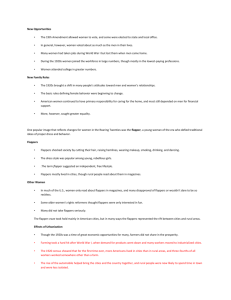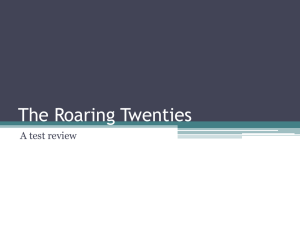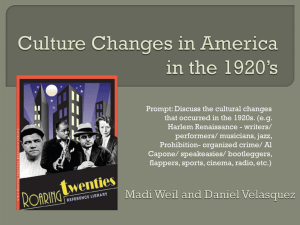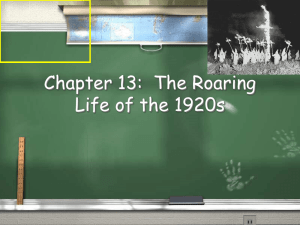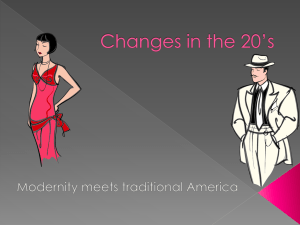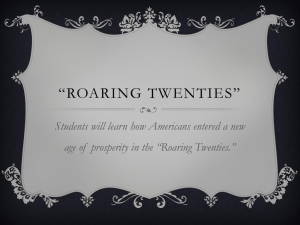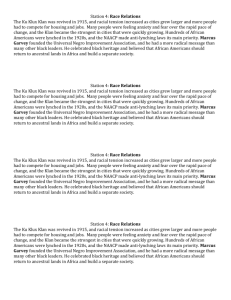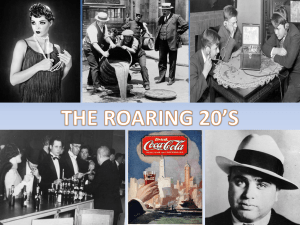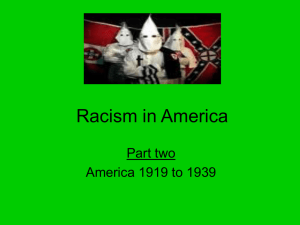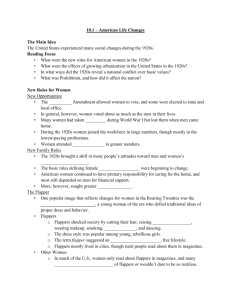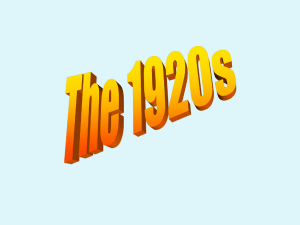The Roaring Twenties
advertisement
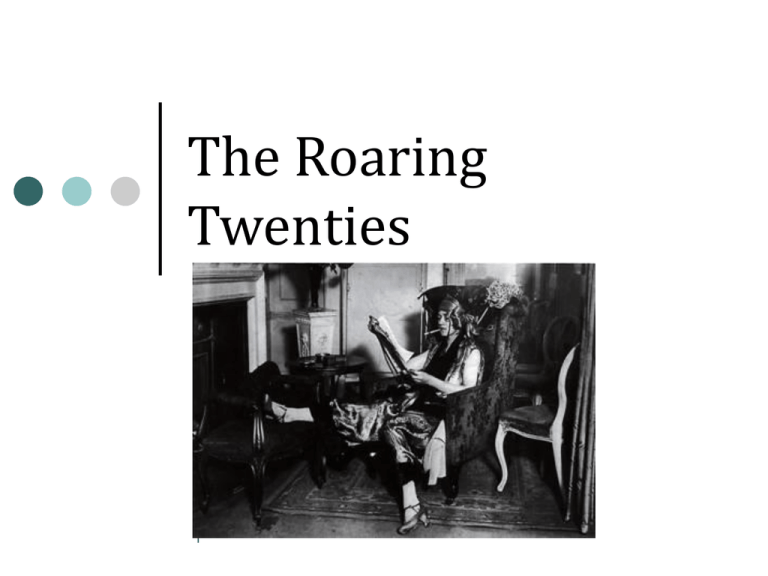
The Roaring Twenties 1 Vocabulary 1. 2. 3. 4. 5. 6. 7. Urban: relating to cities Rural: relating to the country Renaissance: a rebirth or surge of culture. Amendment: a change or addition (in this case to the Constitution) Prohibition: the act of making something illegal; something you are not allowed to do is prohibited. Speakeasies: illegal bars of the 1920s Leisure: free time activities; relaxation 2 What was The Roaring 20s? “Roaring Twenties” is a phrase used to describe the 1920s in the United States. Normality returned to the US after World War I. It was a decade of increased economic prosperity (people had more money) Although in many cases people spent money they didn’t have (credit) Social changes occurred as well as changes in the lifestyle of the average American. 3 New Roles for Women The 19th Amendment allowed women to vote Some were elected to state and local office. Women joined the workforce in large numbers, though mostly in the lowest-paying professions. Women attended college in greater numbers. 4 Flappers The flapper was the name of a dress style that was popular among young, rebellious women of the time. It also came to be another name for the young urban women who wore them The term flapper suggested an independent, free lifestyle. Flappers mostly lived in cities, though rural people read about them in magazines. 5 Quick Quiz 1. 2. 3. 4. What are FOUR major ways of explaining the Roaring Twenties? What amendment to the Constitution gave women the right to vote? What were TWO other new roles for women? What/Who were flappers? 6 Increased Urbanization After World War I, demand for farm products was reduced so many farmers and farm workers moved to industrialized cities. The 1920 census showed that for the first time ever, more Americans lived in cities than in rural areas, and 3/4 of all workers worked somewhere other than a farm. The Automobile also helped bring the cities/country together, rural people were now likely to spend time in town and were less isolated. 7 8 The End of Child Labor Education also increased, and by the 1920s many states passed laws requiring children to attend school, helping force children out of workplaces. School attendance and enrollment increased as industry grew because more people could afford to send their children to school, not to work. 9 New York in the 1920s 10 The rise of the Ku Klux Klan The Ku Klux Klan grew dramatically in the 1920s Many of its members were people from rural America who saw their status declining – this made them angry Members of the Klan continued to use violence, targeting African Americans, Catholics, Jews, and all immigrants. In the 1920s, the Klan focused on influencing politics. The Klan’s membership was mostly in the South but spread nationwide. 11 12 The Great Migration The major relocation of African Americans from the south to northern cities is known as the Great Migration. Many African Americans looked to the North to find freedom and economic opportunities (JOBS) African American newspapers spread the word of opportunities in northern cities, and African Americans streamed into cities such as Chicago and Detroit. African Americans also looked to escape the racism of the South. 13 14 Quick Quiz 1. 2. 3. 4. 5. What did the 1920 census show? How does this relate to the Automobile? What were TWO reasons that child labor was reduced? Why did the Ku Klux Klan grow during the 20s? Where was the Klan mostly located? What were some things the Klan did? What was the Great Migration? Give two reasons that it happened? 15 The Harlem Renaissance The great migration led to large black communities in many of America’s northern cities. Many black Americans moved to a neighborhood of New York City known as Harlem, which became the center of African American culture and activism in the United States. This surge of black culture came to be known as the Harlem Renaissance 16 W.E.B Du Bois A key figure in Harlem’s rise was W.E.B. Du Bois, a well-educated, Massachusetts-born African American leader. In 1909 Du Bois helped found the National Association for the Advancement of Colored People (NAACP) in New York City He was also the editor of a magazine called The Crisis, that published African American writing and poetry. 17 Poets, Artists, & Writers Poets Poets like Claude McKay and Langston Hughes wrote about black defiance and hope. Artists Writers Little African American literature was published before this period of time. Writers like Zora Neale Hurston and James Weldon Johnson wrote about facing white prejudice. Black artists won fame during this era, often focusing on the experiences of African Americans. William H. Johnson, Aaron Douglas and Jacob Lawrence were some well known authors of the time. 18 Quick Quiz 1. 2. 3. 4. What led to the Harlem Renaissance? Who was W.E.B. DuBois? What were TWO important contributions of his? Name at least one famous black POET, ARTIST, and WRITER from this period? What was the topic of many of their pieces of writing/art? 19 Increase usage of Radio The use of radio allowed for faster and more accurate news Radio dance parties became common for times when music was played 20 Hobbies, Sports and Leisure In the 20s people had more free time to watch sports. Sports like baseball, tennis, swimming and boxing were especially popular Heroes like Babe Ruth emerged as pop culture icons 21 The rise of Hollywood The 1920s saw the very beginning of film and the film industry In 1928 Disney’s ‘’Steamboat Willie” was the first animated film with sound. 22 Quick Quiz Explain 2-3 pieces of information about each of the following lifestyle changes of the 1920s: 1. 2. 3. Increase usage of radio Hobbies and Sports The Rise of Hollywood 23 The Fight for Prohibition The movement to ban alcohol was call the Temperance Movement When World War I started, some in the movement argued that grain and grapes, which most alcohol is made from, needed to go towards feeding troops, not alcohol. Others used prejudice against immigrants to fuel their cause by portraying immigrant groups as alcoholics Religious groups favored a liquor ban because they thought alcohol contributed to society’s evils and sins, especially in cities. By 1917 more than half the states had passed a law restricting alcohol use. 24 25 Prohibition achieved! The 18th Amendment banning alcohol was proposed in 1917 and ratified (agreed to) in 1919. This meant the constitution had been changed to make alcohol illegal nation-wide. This national ban on alcohol was called Prohibition 26 Bootleggers and the Speakeasy Prohibition gave rise to huge smuggling operations. Newspapers followed the hunt for bootleggers, or liquor smugglers entering the country. Many people also made their own liquor using homemade equipment, and others got alcohol from doctors, who could prescribe it as medicine. The illegal liquor business was the foundation of great criminal empires, like Chicago gangster Al Capone’s crew, who smashed competition, then frightened and bribed police and officials. 3,000 Prohibition agents nationwide worked to shut down speakeasies, or illegal bars, and to capture illegal liquor and stop gangsters. 27 28 29 Quick Quiz 1. 2. 3. 4. 5. 6. What was prohibition? What major world event made it more likely? How/Why? What were TWO other reasons people gave to support prohibition? What did the 18th Amendment do? Who were bootleggers? Who was Al Capone? What is a speakeasy? 30
